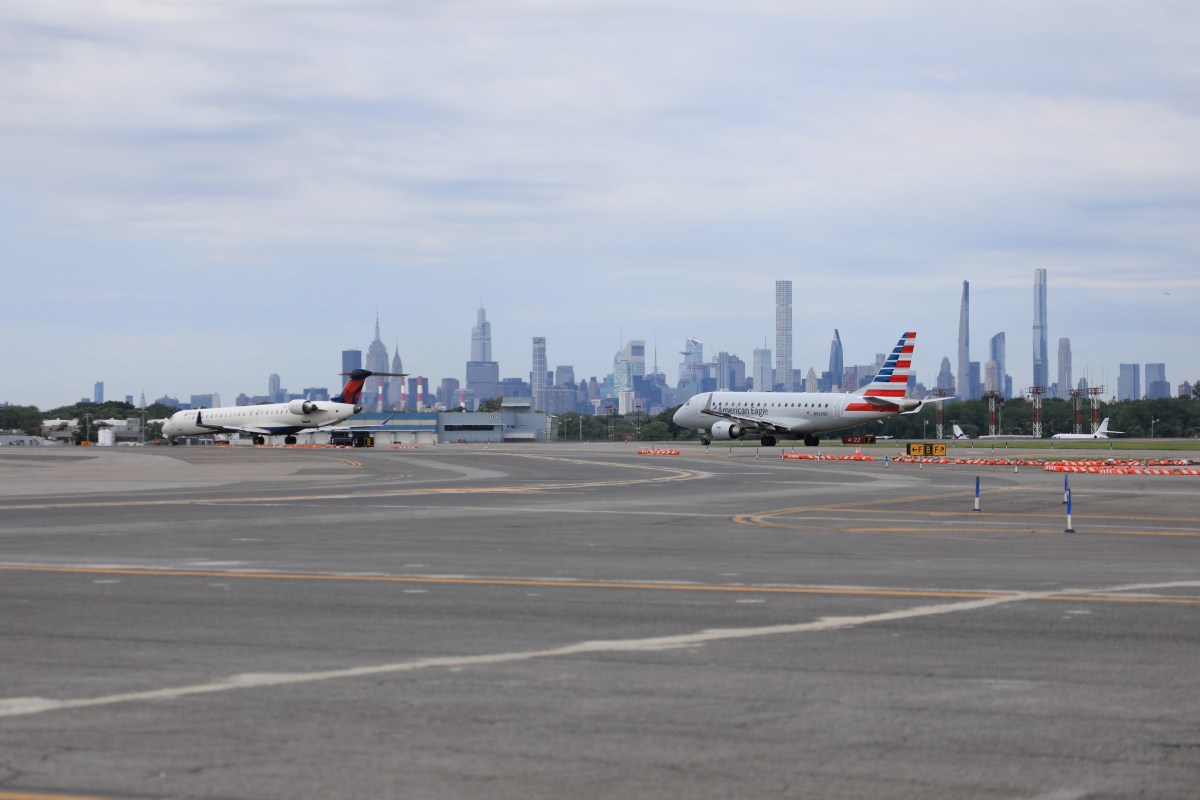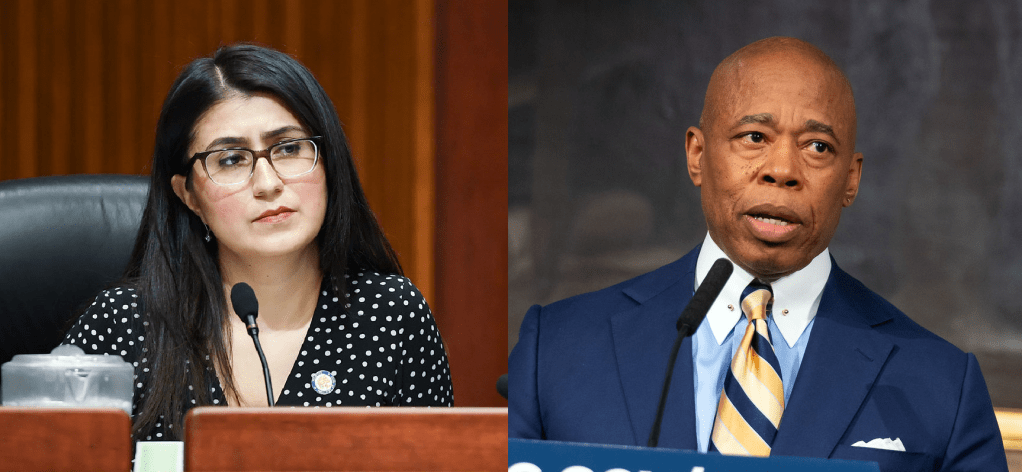By Albert Amateau
Two weeks after the Landmarks Preservation Commission informally but definitely declared the proposed St. Vincent’s Hospital/Rudin redevelopment not appropriate for the Greenwich Village Historic District, the hospital and Rudin presented a brand-new, scaled-back plan.
The revised scenario, made public Monday at a Community Board 2’s St. Vincent’s Omnibus Committee meeting, includes the preservation and residential reuse of four hospital buildings in St. Vincent’s main campus on the east side of Seventh Ave.
Rudin’s proposed residential tower on Seventh Ave. would be 60 feet lower that its 265-foot-tall original proposal. The new plan also calls for the residential tower to be about one-third narrower than the original plan, down to 142 feet along Seventh Ave., instead of the original, 202-feet-wide building, said Dan Kaplan, in charge of the residential project for Fox Fowle architects.
The scaled-down version of the proposed new hospital on the current site of St. Vincent’s O’Toole Building on the west side of the avenue would be “considerably more modest” than the reduction of the Rudin tower on the east side, said Ian Bader, the Pei-Cobb partner in charge of the hospital project. The new plan calls for a 299-foot-tall hospital, instead of the original, 325-foot height. In addition, the footprint of the elliptical tower set diagonally to the street grid would be reduced by 52 feet, opening up the site’s west side to more sky.
The hospital would have the same number of inpatient beds, 360, and the aboveground rectangular base of the hospital would be raised from three to four levels to fit all the medical services in the reduced building.
On the east side of the avenue, instead of demolishing all the buildings, the new plan would modify the Smith and Raskob buildings and the Nurses Residence on W. 11th St. and the Spellman Building on W. 12th St. and convert them to residential apartments.
But the hospital’s Coleman and Link buildings on Seventh Ave. would be demolished to make way for the residential tower, and the Reiss and Cronin buildings would also fall to the wrecker’s ball and be replaced by new, mid-rise apartment buildings.
“It seems to me that we have listened well to the conflicting voices of the community and we hope to take a gigantic leap forward on this project,” Henry Amoroso, president and C.E.O. of St. Vincent’s, told the crowd of neighborhood activists at the May 19 meeting. He also paid tribute to the Rudin family for the considerable moderation of the residential plans.
“We hope you see this as our attempt to accommodate your concerns,” Amoroso told the meeting.
Dan Kaplan, in charge of the Rudin residential project for Fox Fowle architects, described a revised design plan showing how one of several existing St. Vincent’s hospital buildings would be incorporated into the project’s residential component.
William C. Rudin, president of Rudin Management Company, attended the May 19 meeting and issued a separate written statement affirming that, “The Rudin family has been firmly committed to helping St. Vincent’s realize its vitally important mission.” Rudin added that his company “was proud to have reconfigured our plan in a way that pushes this critical project forward.”
The new proposal was submitted to the Landmarks Preservation Commission earlier on Monday and consists of a rarely used and infrequently granted hardship application for the demolition of the O’Toole Building to make way for the new hospital.
In the case the commission decides not to grant an application for demolition of a designated landmark or a building in a historic district, the Landmarks Law allows the owner to file the hardship plea; the owner must try to prove that that the decision prevents or seriously interferes with his or her ability to earn a fair return — usually 6 percent — on his or her investment.
In the case of a nonprofit charity, the standard is different: St. Vincent’s Hospital must prove that denying the right to demolish the O’Toole Building prevents or seriously interferes with the hospital’s charitable mission.
The issue was outlined at the meeting by Shelly Friedman, the land use lawyer for the project, who said St. Vincent’s is making the case that preserving the O’Toole Building would be a physical — not a financial — hardship. St. Vincent’s will try to prove that O’Toole is the only available site to build its state-of-the-art hospital.
Mark Silberman, staff counsel for the Landmarks Commission, was also on hand to explain the hardship issue and announce that L.P.C. would hold a public hearing on the application at 9:30 a.m. Tues., June 3, at New York University School of Law’s Vanderbilt Hall on Washington Square South at MacDougal St. Silberman said the commission would not vote on the project at the June 3 hearing and would hold at least one other meeting on the issue in July.
“The last hardship application at the commission was in the late 1980s and it was a minor matter, nothing as important as St. Vincent’s,” Silberman said. The process gives St.Vincent’s 90 days to make its case, after which the commission must rule on whether the hardship application has merit. A 180-day period follows during which the applicant or L.P.C. must ameliorate the hardship or come up with an alternative to the project. Failing that, the commission has another 90 days to make a recommendation on whether the city should acquire the property for preservation under eminent domain.
Brad Hoylman, C.B. 2 chairperson and head of the board’s St. Vincent’s Omnibus Committee, said the committee would hold “one or more public meetings on the project before July.”
In addition to the hardship issue, St. Vincent’s and Rudin will have to seek a new certificate of appropriateness from L.P.C. for the revised residential redevelopment on the east side of Seventh Ave.
Andrew Berman, director of the Greenwich Village Society for Historic Preservation, who opposed the original plan, asked St. Vincent’s representatives what they would do if one of the applications succeeded and the other failed.
“We’ll cross that bridge when we come to it” was the answer.
Berman said later, “It’s clear that the east campus has some very important changes. The question is where the new residential construction will hit the mark as being appropriate for the historic district. On the hospital side, the question will be answered by the hardship determination.”
The meeting took place in a New York University building on Washington Square East. Outside, the New York State Nurses Association mounted a demonstration protesting the lack of a collective bargaining contract for St. Vincent’s nurses. Signs demanded that St. Vincent’s agree to a safe nurse-patient ratio, recruit new nurses, retain experienced nurses and agree to a fair contract.






































